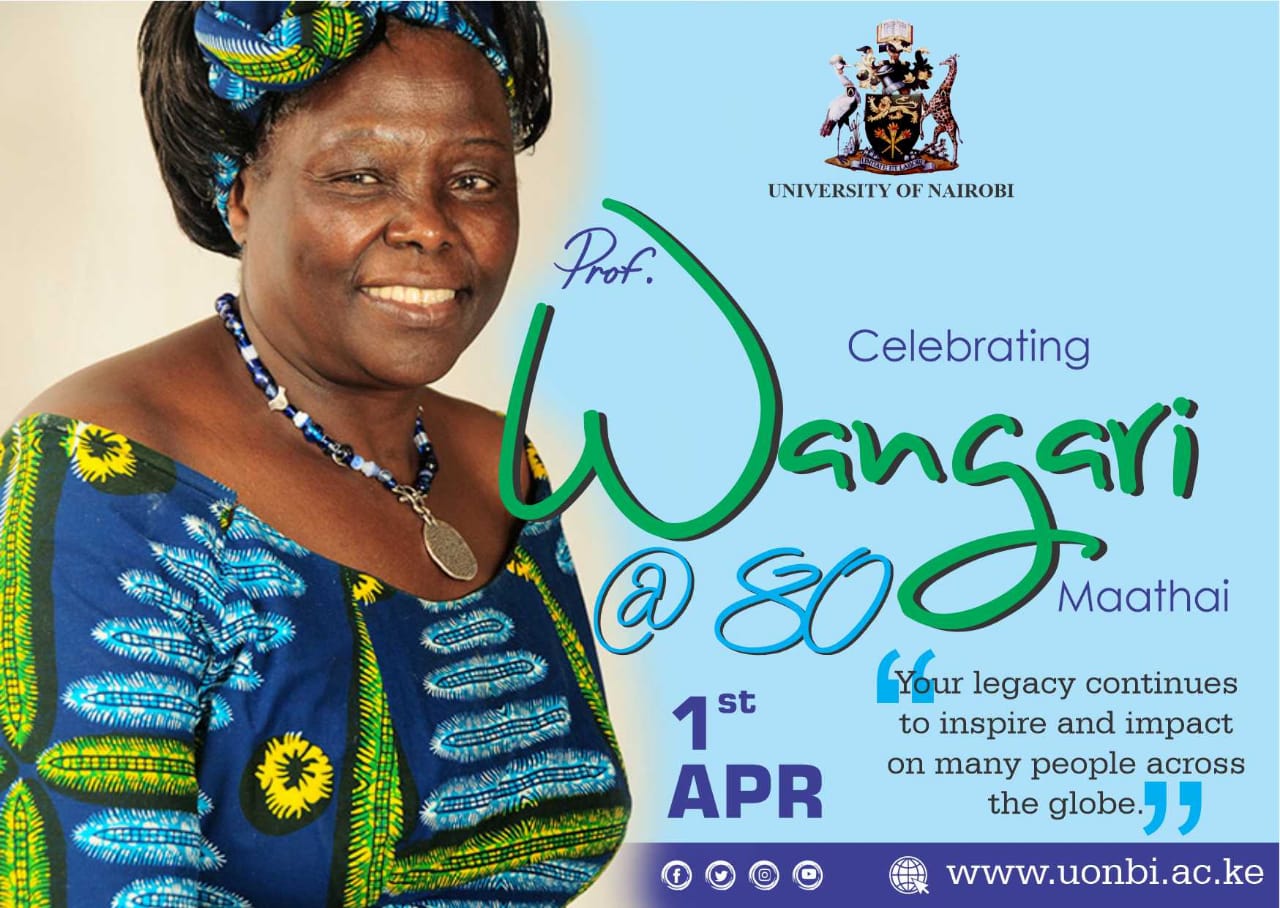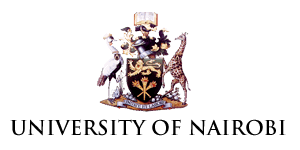Retracing the steps of Nobel Peace Laureate Prof Wangari Muta Maathai @80
Genesis and working with women
A journey that started over forty years ago in the late 1970s, has continued to excite the environmental landscape in different ways. It can also be equated to a journey where women in Kenya lead by a bold women initiated a process, a movement, an idea that continues to reverberate across the nation and beyond. While the initial idea was to address a local problem of women’s burden looking for water in drying streams, insecure food supply and challenges in getting domestic fuelwood, other critical issues emerged like lack of sufficient democratic space, conflicts and their interlinkage with sustainable development. The Green Belt Movement (GBM) provided the much needed vehicle for women, to form groups that would ultimately help to address the challenge of repairing the environment that provides various ecosystem services and goods like food, fuelwood, water and a clean and healthy environment. While the glue was tree planting, she realized early enough that this needed to go hand in hand with community empowerment and restoration of traditional values including traditional foods that enabled communities to protect their natural ecosystem.
The often noted axiom from her was that by planting trees, we are planting seeds of peace. Planting trees symbolizes protection and conservation of forests; it also symbolizes responsible management of our natural resources as a country. Overtime the work of GBM spread beyond Central Kenya where it had started and to every corner of the country strongly driven community organized groups, mainly women but men were also part of these groups though in smaller numbers. To meet other community needs, entrepreneurship became part of these groups, including honey production, selling of tree seedlings and bakery among other aspects. This helped women become independent and operate without wholly depending on GBM resources; a major source of group independence and with this they were able to touch a bigger part of the community. These groups are very much in existence and active up to today, scattered in different parts of Kenya, and extending the legacy of Prof Wangari Maathai. Today Central Kenya presents a landscape covered with trees on the farms that were the works of these groups. Kenya and indeed the world misses her critical thinking and her deep international respect and capacity to mobilize leaders at all levels to address such global challenges as climate change and more recently the corona virus crisis
Evolving dynamics - “nature does not forgive being brutalized”.
Beyond working with grassroot community women groups, she trained her efforts to protection of ecosystem in gazetted ecosystems where communities had little impact then. While they could plant trees and take care of them on their farms, the public forests were under management of central government. In the 1990s, she expanded her efforts to include protection of forests, which were being degraded through illegal allocation and occupation. Forest degradation was suicidal for the country as the very problem that she started to tackle in the 1970s was coming back through forest degradation, now affecting many citizens and economy. The fight for Karura Forest in Nairobi is well documented among other forest ecosystems including the Mt Kenya Forest , the Aberdares, the Mau Forest Complex, and Urban Forests among other public land resources. She extended her fight to wetlands encroachment and open public land along together with other stakeholders, with a strong emphasis that environment fights back, when degraded; a fact she emphasized often. The effects of forest degradation in the 1990s has been witnessed with water scarcity in several parts of the country as exemplified by drying rivers, “nature does not forgive being brutalized”. The fight for Uhuru Park as a public good is well documented although it is now threatened by road infrastructure development. Uhuru Park and Karura Forest are living legacy of her fight for public good, where she was brutalized by the Kenya Police who were protecting those who would despoil the national heritage. This pushed her cause on the world map as an international celebrity. While this continued, she kept strong touch with grass-root women in Kenya and in the rest of the world, on her fight for environment and empowerment. These sites continue to evoke strong emotional attachment to citizens and have continued to inspire environmental protection movements when any threats emerge. At the same time, her fight for the integrity of ecosystems inspired several community groups across the then threatened ecosystems, with the sole aim of protecting forest ecosystems. These groups formed grassroot movements, which provided the much need support to her national effort and today many of these have transformed into community forest associations (CFAs) and continue to provide the much needed support in forest protection and community empowerment. In one of her speeches, she said, “Today we are faced with a challenge that calls for a shift in our thinking, so that humanity stops threatening its life-support system. We are called to assist the Earth to heal her wounds and in the process heal our own - indeed to embrace the whole of creation in all its diversity, beauty and wonder. Recognizing that sustainable development, democracy and peace are indivisible is an idea whose time has come”. This is still very much relevant today and very much in line with the global call for Forest Landscape Restoration (FLR), that aims at healing those degraded landscapes.
Democratic space
In her fight for democratic space to spearhead her ideas at national level, she founded a Green Political Party, The Mazingira Green Party of Kenya (“Mazingira” is Swahili for environment). It was through this political party that she was elected to parliament, appointed an assistant minister for environment, and from there, increased her voice on environmental conservation. Like other green parties globally, it has low uptake. There are still very few green parties in Africa and their political voice is low despite formation of association of green political parties of Africa in 2011. The principles of green politics include social justice, environmentalism and non-violence.
Legacy Living from GBM Works
Working with communities over time, she realised the need to connect trained university graduates knowledge and community willingness to heal the land. In her GBM work, she noted a need for multidisciplinary teams, each team member contributing something to the learning process. Community members providing useful local knowledge and local solutions and graduates providing technical knowledge. One of the lessons she learnt was that graduate students were trained in their respective silo disciplinary mentality and had poor knowledge of what the community problems were, how to solve these problems and pass over the knowledge by talking to barely literate women on deep scientific soil and botanical topics in language they could understand.
She shared how she had come to realize that there is a disconnect between the quality of graduate students and the field in which they were expected to work in; embodied by the mode of content delivery at the university. The mode normally dissected content into clearly demarcated disciplines (lacking in inter-disciplinarily), which were delivered by experts who were really/usually ignorant of other related disciplines. When she hired fresh graduates at the Green Belt Movement, she realized they lacked appreciation of reality of nature, environment and people, all of which are necessary to succeed in their employment.
This challenge is still common today due to limited exposure of University students to problems facing the community, which she realized could be solved by experiential learning. Considering the vast amount of information available in the society both inside and outside the university; if we motivated learners from university and community could sit together to exchange information, a much higher level of learning would be achieved. Prof Maathai had tested this mode of learning over and over again during the training sessions with communities that she periodically held for new recruits for the Green Belt and community leaders. She found it to work exceedingly well and this is what she referred to as experiential learning.
Legacy Living on Wangari Maathai Institute of Peace and Environmental Studies
The genesis of the Institute started over lunch on 27th July 2008, when Prof. Wangari Maathai, Prof Peter Gehr from University of Bern, Prof. Vertistine Mbaya and Prof. S.G. Kiama met for lunch at Fairview Hotel in Nairobi. Prof. Kiama requested Prof. Maathai to consider doing something with the Faculty of Veterinary Medicine particularly in mentoring and motivating students. Prof Maathai responded in the affirmative and requested for another meeting where she could share some of the things that she had also been thinking about concerning engaging her Almer matter, the University of Nairobi. In the subsequent meeting it became clear that Wangari had a bigger vision– The Vision of the Institute.
Following this sharing of her vision, the University of Nairobi and the Green Belt Movement worked with her to realize her dream and in December 2009, the University of Nairobi Council established the Institute. The Institute sits on a 50-acre land which was allocated by the University of Nairobi Council. With funding from the African Development Bank, through the Ministry of Education, Science & Technology, the construction of Phase I of the Institute commenced in 2016 and was completed in early 2018.
In February 2010, the University of Nairobi appointed Prof Maathai, the Founder Distinguished Chair of the newly established Wangari Maathai Institute for Peace and Environmental Studies and Prof. Kiama as the Director, current University of Nairobi, Vice Chancellor. Wangari was very convinced that the establishment of the Institute would bring to reality her vision, a real possibility of training transformational leaders who would bridge theory with practice in the fields of peace and environmental governance and its linkages with democracy. The Institute was very close to her heart and she has shared some of her thoughts on it in her last book “Replenishing the Earth: Spiritual Values for Healing Ourselves and the World “.
To realize this dream today the Institute, has two major programmes; at Masters and Doctoral level that train students from diverse background paying strong attention to experiential learning that taking students out for fieldwork several times (at least once a month) in the course of the semester. Today at WMI, the graduate students both at masters and doctoral level are exposed to community classrooms from time to time, based on resources availability. Specifically at Masters level, a residential session is organized with community members residing with them, learning from each other and exchanging information on issues confronting them and exploring possible solutions. This involves students from diverse disciplines and nationality, mixing cultures, knowledge and traditions for a common purposes. In addition the Institute has positioned itself as a Peace Centre by having peace mediation labs, which are designed to promote cultures of peace, which Prof Wangari Maathai noted is necessary in sustainable development. GBM and WMI continue to work closely by collaborating in various issues affecting society including environment, promotion of cultures of peace and advocacy.
So @80 Prof. Wangari would have been very happy and satisfied to see her legacy ideas propagated through the continuous community and other stakeholders engagement by GBM, and the symbiotic links with WMI, the so far successful training of environmental stewards by the Institute, the design of the Institute based on her ideas that continues to inspire many and the national and international respect that she still commands. May her soul rest in peace.

